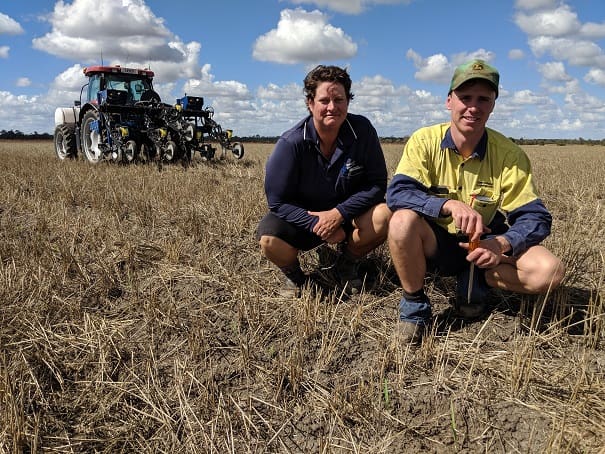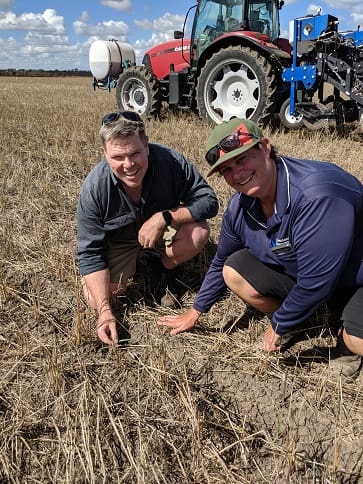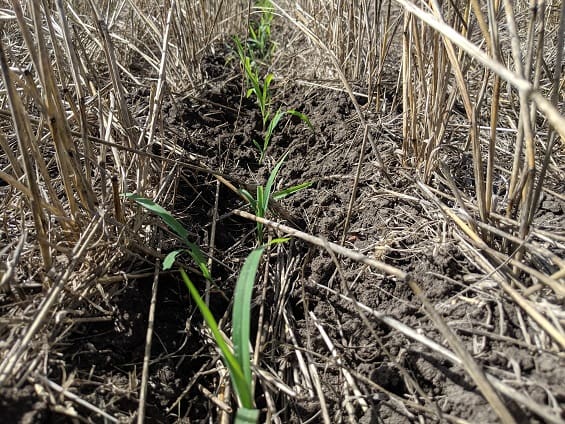
Lead technician for the early sorghum agronomy project at Emerald, Jane Auer, and farm hand, Shaun Johnstone, inspect sorghum sown on June 21 (TOS 1) as they prepare to sow the next planting yesterday.
A TRIAL investigating new sowing dates and lower soil temperature minimums for planting sorghum may lead to a rejigged cropping calendar in the eastern sorghum zone.
Researchers are in the second year of a trial looking into the opportunity to change sorghum sowing times to improve reliability and performance.
The trial is being conducted by Queensland Department of Agriculture and Fisheries (QDAF), New South Wales Department of Primary Industries (NSW DPI) and led by the Queensland Alliance for Agriculture and Food Innovation (QAAFI) with funding from the GRDC.
Trial plantings have been established across a number of sites in the sorghum-growing region from Central Queensland (CQ), the Darling Downs and Mungindi to northern NSW and the Liverpool Plains.
Speaking at the 2019 Summer Grains Conference, QDAF senior regional research agronomist, Darren Aisthorpe, Emerald, said one of the key aims was to identify ‘Goldilocks’ periods when sorghum could flower and grain fill in conditions that weren’t too hot to cause heat stress and weren’t too cold to induce ergot in the heads.

QDAF senior regional research agronomist, Darren Aisthorpe, and lead technician for the early sorghum agronomy project at Emerald, Jane Auer, at the sorghum trial site at Emerald this week.
“In CQ our main sowing period is typically January/February with the view to having the crop flowering in the April/May grain fill period. If you are too much earlier than that you get heat stress, if you are too much later the minimum temperatures start to get into the ergot risk period,” he said.
As a flow on from work in 2017, Mr Aisthorpe said a trial was planted in early August on the Darling Downs by the QAAFI team, when the soil temperatures were much lower than recommended.
“Typically, agronomists say you need a soil temperature of 16 degrees and rising before you plant sorghum. The trial was planted on a soil temperature of about 12 degrees,” he said.
“The trial copped a couple of frosts to minus 2 degrees as the seedlings were coming out of the ground. While they didn’t look happy for a while, plant deaths were minimal.
“And the yield response between the August-sown and the later-sown crops in September/October was quite significant.”
Mr Aisthorpe said that prompted the question of how August-sown sorghum would perform in CQ where spring sorghum had traditionally been seen as very high risk, going straight into a heat period in a typically dry part of the year.
“The opportunity we see is if you get a heap of rain in February to early March, then no rain in April/May to top up the moisture, but you might get some at the end of May. We know wheat yields drop away significantly by the end of May,” he said.
“If at the end of May or early June you suddenly have a full profile, do you go wheat which might give you two tonnes/hectare or is there an opportunity for maybe a four or five t/ha sorghum crop down the line?
“With our high rainfall in December/January/February, you have a high chance of refilling that profile again and going straight back into another winter crop. That’s what we are targeting.”
Mr Aisthorpe said in the first year of the trial sorghum was planted in CQ on July 25 and August 16.
“Unfortunately, we overshot our ‘Goldilocks’ flowering date, but we saw some significant yield differences between time-of-sowing 1 and time-of-sowing 2,” he said.
“We also saw significant screening differences and some significant lodging differences. There was a really high lodging effect in the later-sown sorghum which had the higher heat stress.”
This year Mr Aisthorpe said the trial plantings in CQ would be slightly earlier than the first year.
“We planted on June 21. There will be a mid-July and a mid-August sowing this time to hit the ‘Goldilocks’ period and find out what happens if we miss the ‘Goldilocks’ period. Also this year we have a dryland versus irrigated comparison,” he said.
“What we really want to understand is how cold can we go. We have already identified that across the border in NSW sorghum can’t be planted as early as in CQ because of the soil temperature differences.
“You really need to be around 12 degrees or higher. But that is a significant drop from the old rule of 16 degrees.
“The bigger issue for CQ is all about heat stress, hitting that ‘Goldilocks’ period for flowering and grain fill, reducing the evaporative pressures on the plant so it isn’t working so hard. Hopefully that will lead to better yields and grain quality.”


HAVE YOUR SAY